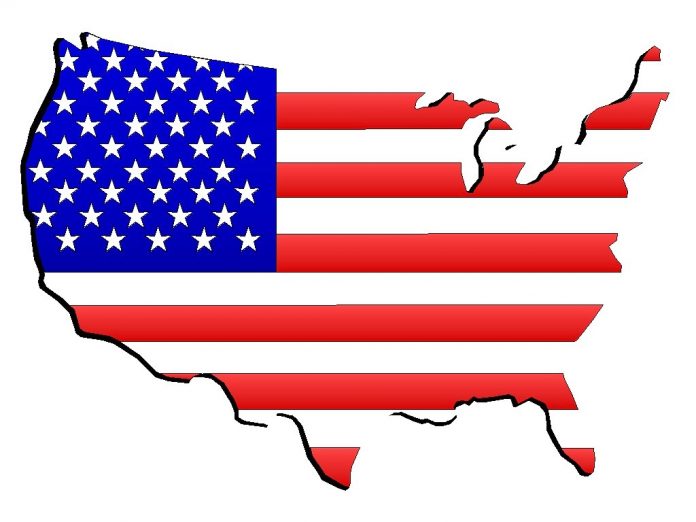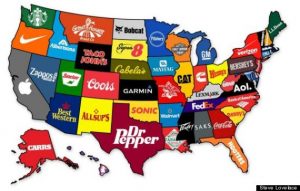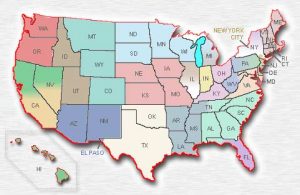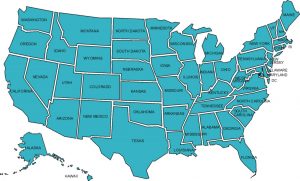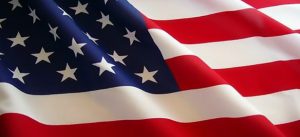History of United States of America – Nation whose main territory consists of North America S of Canada and N of Mexico. It also includes the state of Alaska in the NW corner of North America, the state of Hawaii, consisting of Pacific island s approximately 3,000 mi SW of San Francisco, the Commonwealth of Puerto Rico, and the American Virgin Island s in the West Indies, and until 1999 the Panama Canal Zone. Pacific island s under direct U.S. control include American Samoa, Guam, Midway, the Marianas, and Wake.
In the 15th century
When Europeans first arrived in North America, it was already inhabited by American Indians whose ancestors had come across the Bering Strait from Siberia some time before 30,000 b.c. Although there were only a few million Indians in the area that became the United States, their impact on the early European explorers and settlers was immediate and lasting, as is attested by the large number of Indian names on the land today. The primitive Indian cultures of North America were also strongly affected by the encroaching Europeans: for example, the buffalo-hunting culture of the Great Plains developed only after the western Indians had acquired the horse from the Spanish.
Final defeat of the Indians
From the earliest period of European settlement to the final defeat of the Indians in the 1890s, the story was always much the same. The Indians were at first often friendly and even helpful, but then as the settlers multiplied and encroached on their land s there were wars, usually very bitter, with atrocities on both sides—the Pequot War in Connecticut in 1637, King Philip’s War in New England in 1675–76, the bloody uprising of the Pueblo Indians of New Mexico against the Spanish in 1680, known as the Pueblo Revolt, Pontiac’s Rebellion in the Northwest in 1763, the Indian forays on both sides during the American Revolution, the conquest of the Northwest Territory at Fallen Timbers in 1794 and Tippecanoe in 1811, and then, as the Indians were driven westward, the final protracted Indian Wars on the Great Plains, culminating in 1878. The Indians fought bravely, but in the end were defeated, and those who did not die in battle were decimated by the diseases and the liquor of the settlers or were forcibly moved W, as were the Five Civilized Tribes of Georgia and North Carolina.
Battle of Wounded Knee
The battle of Wounded Knee in 1890 is generally considered the last of the long sequence of wars, After this the remaining Indians were moved onto reservations and reduced to the status of a second-class minority, as they still are considered by many today, Exploration of the present continental United States began in 1498 and was carried on mainly by Spanish, French, and English explorers. Spain made the first settlement in the area at St. Augustine, Florida, in 1565; while the first permanent settlement by England was at Jamestown, Virginia, in 1607. By 1733 there were 13 British colonies along the Atlantic seaboard. Agriculture, mostly by small yeoman farmers, was the main occupation; while black slave labor was used, particularly on the larger southern plantations. After France was driven out of eastern North America in 1763 at the end of the French and Indian War, the colonists saw less need for British protection and forcefully resisted both taxes levied by the British for imperial defense and their mercantilism system of discouraging colonial industry in favor of importing raw materials to the mother country.
Royal Prerogatives and Powers
The conflict, fed by abuses of royal prerogatives and powers, became armed rebellion in the American Revolution. The first hostilities took place in 1775, and the colonies declared their independence on July 4, 1776. They achieved independence, however, only in 1783 when the British admitted defeat, relinquishing to the United States their rule over almost all the land E of the Mississippi River and S of Canada.
The weak Articles of Confederation of 1781 were replaced by the present Constitution in 1789, establishing a federal republic with a strong central government.
The document was ratified by the new states between 1787 and 1790. George Washington, command er of the Continental Army during the Revolution, was named the first president.
The early republic pursued its agricultural life along the coast, but in 1803, through the Louisiana Purchase, President Thomas Jefferson acquired a large region W of the Mississippi from France. The War of 1812 began ostensibly because of British interference with American shipping, but it was strongly opposed in New England and among commercial interests. After victories and defeats on both sides, the war ended in 1815 with no changes in boundaries or other matters. There followed an era of growth as industry, chiefly water-powered, developed and settlers spread westward. Growing sectional differences over slavery, political autonomy, and differing economies between North and South were temporarily resolved by the Missouri Compromise of 1820. The election of President Andrew Jackson, a Democrat, in 1828 opened a period of the “common man,” coupled with a new spirit of nationalism expressed in the term Manifest Destiny. In 1846 an agreement with Great Britain settled the boundaries of the Oregon Country, and in 1845 Texas was annexed. The latter led to the Mexican War of 1848 by which the United States acquired the rest of its continental territory, except for the Gadsden Purchase of 1853 and the purchase of Alaska from Russia in 1867.
Kansas-Nebraska Act
The Compromise of 1850 again averted a crisis over slavery, but the Kansas-Nebraska Act of 1854 weakened the previous compromises and , as northern abolitionists became more assertive, intensified the North-South conflict. The election of Abraham Lincoln, a Republican, in 1860 triggered the secession of 11 slave-holding southern states. The Civil War followed, from 1861 to 1865, a bloody and bitter struggle that was eventually won by the North. Though the nation was reunited and slavery abolished, the scars of the ensuing Reconstruction period left the South desperate and impoverished and many issues of local and civil rights unresolved. The Gilded Age that followed was marked by corruption and vulgar displays of wealth, but at the same time by unprecedented industrial growth and the development of new capitalist institutions. At the end of the century the western frontier was finally closed, and the country saw a new wave of immigration from Europe. The last decades of the 19th century also saw rapid urban growth, the organizing of labor to obtain decent work and living conditions, and of the farmers to protect themselves from rapacious railroads and banks. The complex, urbanized industrial society we have today had its roots in this period.
Spanish-American War
The Spanish-American War of 1898 resulted in the acquisition of Puerto Rico, the Philippine Island s, and Guam. That year, also, the Hawaiian Island s were annexed. The Panama Canal Zone was secured in 1903 and the Panama Canal built, from 1904 to 1914, to link the Atlantic and Pacific Oceans by water. In the early years of the 20th century, when the Republican Theodore Roosevelt was president, the Progressive and Populist movements brought about much-needed government reforms, a pure food act, and laws to conserve natural resources, as well as to regulate the corporate, financial, and industrial institutions of the country. Under Roosevelt the United States began for the first time to demonstrate its strength and importance as a world power.
Elected president in 1912, Woodrow Wilson, in a bow to the spirit of reform, proclaimed the New Freedom and in 1913 sponsored the establishment of the Federal Reserve System to regulate the nation’s finances. Winning reelection in 1916 on a pledge to keep the United States out of World War I, then raging in Europe, he stressed U.S. neutrality in Big Power conflicts. Nevertheless, he was forced to bring the nation into the war in April 1917, U.S. troops contributing to the final victory over Germany in 1918.
Versailles Peace Conference
At the Versailles Peace Conference that followed, Wilson was the acknowledged world leader, but when he brought the treaty home, the Senate refused to approve U.S. membership in his own creation, the League of Nations. A period of hectic prosperity in the 1920s led, in October 1929, to the famous stock market crash, which had been preceded by business and farm failures. The country was plunged into the Great Depression, the worst economic collapse in the nation’s history. The election of Franklin D. Roosevelt, a Democrat, in 1932 ushered in the liberal New Deal period, during which the Securities and Exchange Commission was established, the Social Security Administration set up, and a host of industrial, financial, business, farm, and social laws enacted in an attempt to make the federal government a catalyst for recovery.
A sudden attack by Japan on the U.S.
In World War II the nation was at first again officially neutral, but soon began giving aid to the Allies, especially to beleaguered Great Britain. A sudden attack by Japan on the U.S. base at Pearl Harbor in Hawaii on December 7, 1941, however, thrust the country into war with both Japan and the Axis alliance of Germany and Italy. After Germany surrendered on May 7, 1945, the United States dropped the first atomic bombs on Hiroshima and Nagasaki in Japan, forcing that country into surrender on August 14. During 1945 the United States played a leading role in the creation of the United Nations, and between 1947 and 1952 operated the Marshall Plan, giving large amounts of aid to help rebuild the shattered nations of western Europe. As a result of the war, the United States and the USSR became the world’s two first superpowers, and the confrontation between them led to the cold war struggle for ideological, political, and economic supremacy throughout the world. One result was the creation of the North Atlantic Treaty Organization (NATO) in 1949, which was countered in 1955 by the setting up of a Russian-dominated similar grouping, the Warsaw Pact Treaty Organization.
North Korean forces invaded the U.S.
The Korean War from 1950 to 1953 began when North Korean forces invaded the U.S.-protected South Korea. After a back-and -forth struggle that also involved UN and Chinese forces, the war ended with the reinstatement of the previous boundary. In the United States, as a result of the Korean War, the continued cold war, and the acquisition of atomic weapons by the USSR, the McCarthy era set in, a period of intense anticommunist feeling, of increased defense consciousness, purges of leftists and liberals, and the blacklisting of media and industrial figures.
Presidency of Dwight D. Eisenhower
During the presidency of Dwight D. Eisenhower, a Republican, from 1953 to 1961, economic conditions improved while the country once more reached a consensus in public policy. The administration’s outlook was international, though tinged with the strong anticommunism of the country as a whole. The launching of the first satellite into space in 1958 by the USSR shocked the country and led to U.S. competition in sciences and technology, producing the first intercontinental missiles and space flights by both countries.
In 1954 the Supreme Court, in an epic decision, declared segregation in public schools on the basis of race unconstitutional, resulting in the ensuing years of much civil strife, especially in the South, and other civil rights issues were fought out at the same time.
The 1960s saw a period of great social unrest, mobility, and conflict, especially on the student campuses, with the nuclear threat overshadowing all. When it was discovered in the fall of 1962 that the Soviets were placing missiles in Cuba, the United States and the USSR came close to nuclear war, but with careful diplomacy the Soviets were persuaded to remove the missiles. After the assassination of President John F.Kennedy in November 1963, President Lyndon B.Johnson announced the Great Society program, which resulted in strong civil rights legislation and antipoverty measures that set government goals for the decade.
United States involved in war in Vietnam
While the Great Society was growing at home, the United States gradually became involved in war in Vietnam, with support troops and advisers first sent east in 1961. As the war escalated, so did U.S. participation in the actual fighting. By the time the war ended in early 1973, with a cease-fire and withdrawal of U.S. forces, the United States had not achieved its goal of containing communism and supporting the South Vietnamese regime. At home there had been much unrest. Hundreds of thousand s had mobilized to demand an end to the war, while concern over the civil rights issue and the continuing lack of economic opportunity for blacks sometimes led to violent and destructive riots in many cities during the 1960s. At the same time, and largely among the young, the counterculture, dedicated to alternative life-styles and communal living, had a brief flowering. Meanwhile, in striking contrast, two U.S. astronauts in July 1969 became the first humans to set foot on the moon.
Surprise visit to China
In February 1972 President Richard M. Nixon made a surprise visit to China, with which the United States had had no relations for nearly a quarter of a century since the communist takeover, thus demonstrating the effectiveness of a new policy of practical detente. That year, however, also saw the beginning of the infamous Watergate Affair. Because the president had tried to cover up the illegal activities of some of his White House aides and was implicated in other illegalities, he was forced to resign his office on August 9, 1974. The aftermath of the 1960s, of the Vietnam War, and the revelation of corruption in high places shook the American people, while at the same time the economy began to falter. Growing inflation was aggravated in late 1973 when the petroleum-producing nations in the OPEC organization temporarily cut off the supply of oil to the United States and the West.
Energy Crisis
The “energy crisis” became a seemingly permanent problem, as did unemployment and inflation, Two decades of conflict and crisis were reflected in the ambivalent administration of President Jimmy Carter. Although the Senate ratified treaties with Panama, giving that nation possession of the Panama Canal by the end of the century, many saw this as a collapse of U.S. firmness in foreign relations. The Senate refused to act on a strategic arms limitation with the USSR, but on the other hand full diplomatic relations with China were resumed in December 1978. In December 1979, Islamic militants seized the U.S. embassy in Tehran, Iran, and held the personnel hostage until January 1981. Carter’s Republican successor, President Ronald Reagan, succeeded in getting through Congress in 1981 his program of very large federal budget reductions, particularly in the social programs of his Democratic predecessors, as well as sizable cuts in the income tax.
New Economic Policies
At the same time he pressed for greatly increased military expenditures. In 1982, as a nationwide recession deepened and unemployment approached Great Depression levels, Reagan’s economic policies came under strong attack from liberals as well as working-class people, while conservatives continued to press for the new economic policies and a revived anticommunist crusade. The results of mid-term elections held in November 1982 forced the Reagan administration to readjust many of its goals. Nevertheless by 1983 recovery appeared to be in sight.
In 1983 241 U.S. Marines stationed in Beirut, Lebanon as part of a UN peacekeeping force were killed by a suicide truck bomb. Later that year the United States invaded the Caribbean nation of Grenada, removing a pro-Cuban government. In 1986 NASA’s manned space program was set back as the space shuttle Challenger exploded shortly after liftoff, killing the entire crew, including six astronauts and Sharon Christa McAuliffe, a civilian schoolteacher.
Air strikes against Libya
In 1986 Reagan ordered air strikes against Libya in retaliation for the Libyan-sponsored terrorist attack in West Berlin that killed two American servicemen. Reagan’s legacy included a buildup of the military that contributed to the collapse of the Soviet Union, the appointment of three Supreme Court justices including Sand ra Day O’Connor, the first woman to serve on the high court. On the negative side, Reagan’s administration was dogged by the Iran-contra scand als where arms were sold to Iran in exchange for the release of American hostages, and then the profits funneled to contra rebels in Nicaragua.
In 1988, Reagan’s vice president George H. W. Bush was elected in a campaign noted for negative campaigning practices. Bush continued Reagan’s policies in foreign affairs. In 1989, after a failed U.S.- backed coup to oust Panamanian president Manuel Noriega, Bush ordered the invasion of Panama.
Noriega was eventually captured in early 1990 and sent to Miami, Florida, to stand trial for drug trafficking.
Iraq invaded Kuwait
After Iraq invaded Kuwait in 1990, the United States with strong support from allies liberated Kuwait in operations Desert Shield (which was a naval and air blockade and the deployment of U.S. and allied military forces to Saudi Arabia) and Desert Storm (which was a 100-hour air and land invasion in 1991). The fast, decisive U.S. victory, combined with almost no American casualties, gave President Bush the highest public approval rating in history.
Economic Problems
That popularity rating quickly disintegrated as economic problems including a $500 billion collapse of the savings and loan industry, a shrinking military due to end of the cold war and collapse of the Soviet Union and Warsaw Pact, and the beginning of a trend of outsourcing of manufacturing jobs to Asia and Latin America. The United States was shifting during the 1980s and early 1990s, economically, demographically, and politically. The nation was shifting from manufacturing to service sector jobs, pushing growth in the southern and western “sunbelt states” at the expense of the northeastern and Midwestern manufacturing states.
The Presidential Election 1992
In 1992, William “Bill” Clinton won the presidential election on a moderate platform emphasizing the economy. Under Clinton, an improving economy and tax increases reduced the budget deficit and eventually created a budget surplus. In 1992 the United States, Canada, and Mexico signed an agreement to create the North American Free Trade Agreement to make North America more competitive in the world markets. Clinton withdrew U.S. troops from Somalia after highly publicized casualties in an ill-defined mission initiated by Bush, while sending troops to Haiti to stabilize democratic authority. Clinton had continual problem with Congress, especially after 1994, when the opposing Republicans won control of both the House and the Senate. A proposed overhaul of the U.S. healthcare system died in Congress and the budget process became a yearly logjam. In 1995 in the worst act of terrorism to date on American soil, a bomb was exploded at the federal building in Oklahoma City by right-wing extremists, killing 169 people. In 1995, the United States brokered a peace plan in Dayton, Ohio, that created a peace in the Yugoslavian civil war.
In 1996, Clinton easily won reelection but was dogged by continual Republican investigations of alleged financial and sexual improprieties. While no convictions of any financial crimes were found after years of investigation and millions of dollars, independent prosecutor Kenneth Starr eventually made public the Lewinsky scand al, which led to impeachment proceeding against President Clinton. Clinton was acquitted of all charges in 1998, but the public trial created a partisan schism in America between conservatives and liberals that continued into the next century. The late 1990s also saw a sustained economic boom with record-high stock market values and low unemployment and inflation. In late 1999 and early 2000, the stock market dropped as overvalued technology stocks lost much of their value.
The Presidential Election 2000
The 2000 presidential election, President Bush’s son George W. Bush defeated Vice President Al Gore in an election so close that it required the Supreme Court to decide to stop the challenges to contested votes in Florida. Gore won the popular vote, but G. W. Bush was deemed the winner on the elector vote count, The election was decided in what many consider to be an ideologically split vote in the Supreme Court. The new Bush administration was further hand icapped by an economy in recession and tense relations with allies over the U.S. rejection of the Kyoto protocols on global warming and a proposed anti-ballistic missile system.
Terrorist attacks on the World Trade Center
The Bush administration turned around public and international opinion in 2001 as the September 11th terrorist attacks on the World Trade Center in New York and the Pentagon in Washington, D.C., brought the country and the world together as few events had done before. Some 3,000 persons were killed or missing as a result of the attacks, Osama bin Laden, a Saudi-born Islamic militant’s al Qaeda terrorist group claimed responsibility for the attacks. Insisting that no distinction would be made between terrorists and those who harbored them, Bush demand ed that Afghanistan’s Taliban government turn over the masterminds. With no Taliban cooperation forthcoming, the United States, Britain, and allies launched air strikes and ground raids on Afghanistan. The United States also provided support for opposition forces in Afghanistan, and the Taliban government quickly fell. Bin Laden, however, remained uncaptured, and a force of U.S. troops was based in Afghanistan to search for him and to help with mopping-up operations.
High unemployment levels
Although consumer spending and the stock market rebounded somewhat, the budget surplus disappeared and deficits grew as a result of tax cuts, war spending, and high unemployment levels. Prompted by a number of corporate scand als involving fraudulent or questionable accounting practices, including the collapse of the Enron Corporation, Congress passed legislation that overhauled securities and corporate laws in 2002. During 2002 the Bush administration became publicly concerned about alleged Iraqi development and possession of weapons of mass destruction. A buildup of military forces began, but public focus shifted in February 2003, with the breakup of the space shuttle Columbia shocking the nation and grounding NASA’s shuttle fleet.
United Sate Allies
Despite vocal opposition to military action from many nations, including many erstwhile allies such as France, Germany, and Russia, the United States and Great Britain pressed forward in early 2003 with military preparations. Although Turkey refused to allow use of its territory as a staging area, the bulk of the forces were nonetheless in place by March 2003. A short and decisive air and land invasion had American and British forces quickly in control of Iraq. No weapons of mass destruction, however, were found by allied forces during the months after the war. The cost of the military campaign and occupation of Iraq created a record-breaking U.S. deficit in 2003. In August 2003, a massive electrical blackout affected the NE United States and Canada prompted an investigation into the maintenance and safeguards of an aging electrical infrastructure.
In the second half of 2003, the economy improved and a Medicare prescription drug benefit was passed as well as initial agreement on a Central American Free Trade Agreement. The lack of weapons of mass destruction in Iraq along with lapses in U.S. intelligence prior to the 9–11 terrorist attacks led to a bipartisan investigation of U.S. intelligence agencies and a report calling for reform.
In 2004, as the Iraqi insurgency grew stronger, Bush defeated the Democratic nominee John Kerry in another bitterly partisan election. Amid greatly increased voter turnout, Bush secured a clear majority of the popular vote, in sharp contrast to the 2000 election.
The Republicans also increased their margins of control in both houses of Congress, largely through victories in the more conservative South. They forfeited these gains after elections in November 2006.


